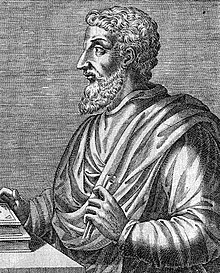மார்கசு தெரென்டியசு வர்ரோ

மார்கசு தெரென்டியசு வர்ரோ (Marcus Terentius Varro) (கி.மு. 116-27) ஓர் உரோமானிய பல்துறை அறிஞரும் மற்றும் ஒரு சிறந்த எழுத்தாளரும் ஆவார். இவர் பண்டைய உரோமின் மிகப் பெரிய அறிஞராகக் கருதப்படுகிறார். மேலும் இத்தாலிய மறுமலர்ச்சியின் அறிஞரான பெட்ராக்கால் "உரோமின் மூன்றாவது பெரிய ஒளி" ( வேர்ஜில் மற்றும் சிசரோவிற்குப் பிறகு) என்று விவரிக்கப்பட்டார்.[1] இவரது சமகாலத்தவரான வர்ரோ அட்டாசினசிடமிருந்து இவரை வேறுபடுத்துவதற்காக இவர் சில சமயங்களில் வர்ரோ ரியாட்டினசு என்று அழைக்கப்படுகிறார்.
வாழ்க்கை[தொகு]
வர்ரோ, இரீட் அல்லது அதற்கு அருகில் (இப்போது லாசியோவில் உள்ள ரைட்டி ) பிறந்தார். இரெடைன் சமவெளியில் தனது முதுமை வரை ஒரு பெரிய பண்ணையைக் கொண்டிருந்தர். இவர் உரோமைக் குடியரசின் செனட் சபை உறுப்பினரும், உரோமைப் போர்ப்படைத் தளபதியுமான பாம்பேயை ஆதரித்தார். உரோமை மக்கள் குடியரசின் அலுவலகத்தில் பணியாற்றிய பிறகு, உரோமின் நீதிமன்றத் தீர்ப்பாயத்தில் சேர்ந்தார்.[2]கபுவா மற்றும் காம்பானியா (கி.மு.59) மீள்குடியேற்றத்திற்கான சீசரின் மாபெரும் விவசாயத் திட்டத்தைச் செயல்படுத்திய இருபது பேர் கொண்ட குழுவில் இவரும் இருந்தார்.[3] [2]
பணிகள்[தொகு]
வர்ரோவின் இலக்கிய வெளியீடு செழிப்பாக இருந்தது. இவர் தனது 89 ஆண்டுகால வாழ்வில் 620 தொகுதிகளை கொண்ட 74 புத்தகங்களை வெளியிட்டுள்ளார். அவற்றில் ஒரே ஒரு படைப்பு மட்டுமே முழுமையானது. உரோமானிய கல்வியாளரும் மற்றும் சொல்லாட்சிக் கலைஞருமான குயின்டிலியன் என்பவரால் "உரோமானியர்களில் மிகவும் கற்றவர்" என்று அழைக்கப்பட்டார்.[4] மேலும் புளூடாட்க்கால் "உரோமானிய வரலாற்றில் ஆழமாகப் படித்த மனிதர்" என்றும் அங்கீகரிக்கப்பட்டார்.[5]
பல பண்டைய எழுத்தாளர்களால் வர்ரோ ஒரு முக்கிய ஆதாரமாக அங்கீகரிக்கப்பட்டார். அவர்களில் சிசெரோ, மூத்த பிளினி, வேர்ஜில் ஜார்ஜிக்ஸ், கொலுமெல்லா, ஆலஸ் கெல்லியஸ், மேக்ரோபியஸ், ஹிப்போவின் அகஸ்டீன் மற்றும் மார்க்கஸ் விட்ருவியஸ் பொல்லியோ ஆகியோர் இவருக்கு (VII.Intr.14) பெருமை சேர்த்துள்ளனர்.
"விவசாயம் பற்றிய மூன்று புத்தகங்கள்" என்ற இவரது ஒரே முழுமையான பணியானது, "அனுபவம் வாய்ந்த மற்றும் வெற்றிகரமான விவசாயியின் நன்கு செரிக்கப்பட்ட அமைப்பு" என்று விவரிக்கப்பட்டுள்ளது. இவர் பதிவுசெய்த அனைத்தையும் பயிற்சி செய்து எழுதியுள்ளார்.[6]
நுண்ணுயிரியல் மற்றும் நோய்ப்பரவலியல் பற்றிய தனது அறிவால் சதுப்பு நிலங்களை தவிர்க்குமாறு வர்ரோ தனது எழுத்துகளில் வாசகர்களை இவ்வாறு எச்சரித்தார்:
...கண்களால் பார்க்க முடியாத, ஆனால் காற்றில் மிதந்து வாய் மற்றும் மூக்கு வழியாக உடலுக்குள் நுழைந்து கடுமையான நோய்களை உண்டாக்கும் சில நுண்ணிய உயிரினங்கள் உள்ளன.[7][8][9]
மேற்கோள்கள்[தொகு]
- ↑ Oxford Classical Dictionary, "Terentius Varro, Marcus"
- ↑ 2.0 2.1
 Reid, James Smith (1911). "Varro, Marcus Terentius". பிரித்தானிக்கா கலைக்களஞ்சியம் (11th) 27. Cambridge University Press. 923–924.
Reid, James Smith (1911). "Varro, Marcus Terentius". பிரித்தானிக்கா கலைக்களஞ்சியம் (11th) 27. Cambridge University Press. 923–924.
- ↑ Baynes, Thomas Spencer (1891) (in en). The Encyclopaedia Britannica: A Dictionary of Arts, Sciences, and General Literature. C. Scribner's sons. https://books.google.com/books?id=_jhKAAAAYAAJ&q=VARRO+praetor%2C+after+having+been+tribune+of+the+people%2C+quaestor+and+curule+aedile.&pg=PA92.
- ↑ Quintilian. "Chapter 1". Institutio Oratoria. Book X. Verse 95. https://penelope.uchicago.edu/Thayer/E/Roman/Texts/Quintilian/Institutio_Oratoria/10A*.html#1.95.
- ↑ Plutarch. Life of Romulus. New York: Modern Library. பக். 31.
- ↑ Harrison, Fairfax (1918). "Note Upon the Roman Agronomists". Roman Farm Management. New York: The Macmillan Company. பக். 1–14 [10]. https://archive.org/details/romanfarmmanagem02harruoft.
- ↑ Varro, Marcus Terentius (2014). De Re Rustica. Loeb Classical Library. I.12.2. https://penelope.uchicago.edu/Thayer/E/Roman/Texts/Varro/de_Re_Rustica/1*.html#12.2.
- ↑ Thompson, Sue (March 2014). "From Ground to Tap". The Mole: 3 (sidebar). http://mag.digitalpc.co.uk/fvx/rsc/themole/1403/. பார்த்த நாள்: August 21, 2017.
- ↑ Hempelmann, Ernst; Krafts, Kristine (October 2013). "Bad Air, Amulets and Mosquitoes: 2,000 Years of Changing Perspectives on Malaria". Malaria Journal 12: 232. doi:10.1186/1475-2875-12-232. பன்னாட்டுத் தர தொடர் எண்:1475-2875. பப்மெட்:23835014.
மேலும் படிக்க[தொகு]
- Cardauns, B. Marcus Terentius Varro: Einführung in sein Werk. Heidelberger Studienhefte zur Altertumswissenschaft. Heidelberg, Germany: C. Winter, 2001.
- d’Alessandro, P. “Varrone e la tradizione metrica antica”. Spudasmata, volume 143. Hildesheim; Zürich; New York: Georg Olms Verlag, 2012.
- Dahlmann, H.M. “Terentius Varro. Paulys Realencyclopädie der classischen Altertumswissenschaft”. Supplement 6, Abretten bis Thunudromon. Edited by Wilhelm Kroll, 1172–1277. Stuttgart: Metzler, 1935.
- Ferriss-Hill, J. “Varro’s Intuition of Cognate Relationships.” Illinois Classical Studies, volume 39, 2014, pp. 81–108.
- Freudenburg, K. "The Afterlife of Varro in Horace's Sermones: Generic Issues in Roman Satire." Generic Interfaces in Latin Literature: Encounters, Interactions and Transformations, edited by Stavros Frangoulidis, De Gruyter, 2013, pp. 297–336.
- Kronenberg, L. Allegories of Farming from Greece and Rome: Philosophical Satire in Xenophon, Varro and Virgil. Cambridge/New York: Cambridge University Press, 2009.
- Nelsestuen, G. Varro the Agronomist: Political Philosophy, Satire, and Agriculture in the Late Republic. Columbus: Ohio State University Press, 2015.
- Richardson, J.S. “The Triumph of Metellus Scipio and the Dramatic Date of Varro, RR 3.” The Classical Quarterly, volume 33, no. 2, 1983, pp. 456–463.
- Taylor, D.J.. Declinatio : A Study of the Linguistic Theory of Marcus Terentius Varro. Amsterdam: John Benjamins Publishing Company, 1974.
- Van Nuffelen, P. “Varro’s Divine Antiquities: Roman Religion as an Image of Truth.” Classical Philology, volume 105, no. 2, 2010, pp. 162–188.
வெளி இணைப்புகள்[தொகு]
- Marcus Terentius Varro: latin works in the latin Wikisource.
- de Re Rustica (Latin and English at LacusCurtius)
- Links to translation of De Linga Latina by R.G.Kent
- Livius.org: Varronian chronology பரணிடப்பட்டது 7 அக்டோபர் 2014 at the வந்தவழி இயந்திரம்
- thelatinlibrary.com: Latin works of Varro
- Oxford Classical Dictionary
- Oxford Bibliographies
